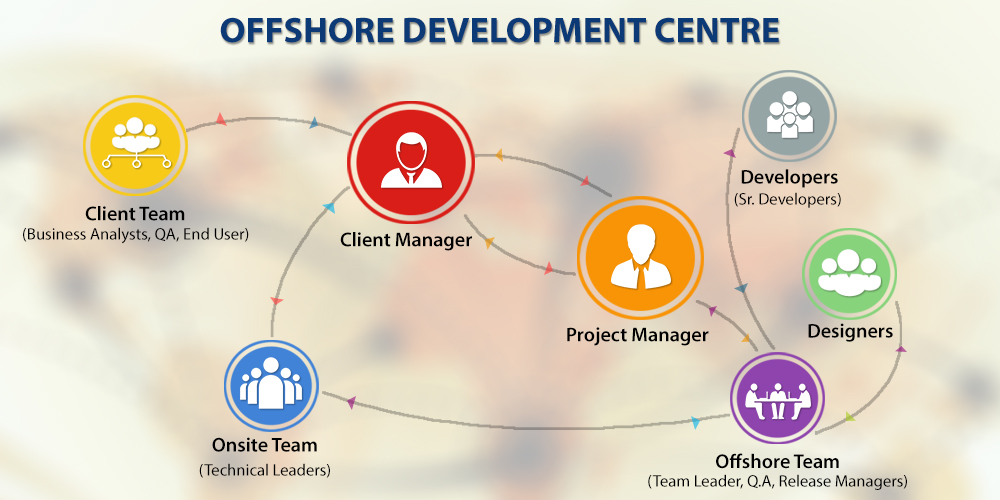The software development landscape is constantly evolving. Companies are increasingly seeking ways to access top talent, optimize costs, and achieve greater agility. This is where Offshore Software Development Center (ODCs) come into play. An offshore software development center offers a dedicated team of developers located in a different country, working collaboratively with your onshore team to bring your software vision to life. But how do you build a high-performing ODC that delivers exceptional results?
Why Build an Offshore Software Development Center?
There are several compelling reasons to consider establishing an offshore software development center:
- Access to Specialized Talent Pools: While a global talent pool offers a wider range of developers in general, ODCs can provide a more targeted advantage. Certain regions may be known for nurturing expertise in specific technologies or industries. For example, Eastern Europe has a strong reputation for developers skilled in web development using React. By setting up an ODC in such a region, you can directly tap into a pool of developers with the specific skillset perfectly aligned with your project’s needs.
- Enhanced Innovation: Building a team with diverse backgrounds and experiences can spark a culture of innovation. An ODC team working in a different country will bring a fresh perspective to your project, potentially leading to new ideas and approaches that might not have emerged within your onshore team. This cross-pollination of ideas can be a significant driver of creative problem-solving and groundbreaking solutions.
- Faster Time-to-Market: The time zone difference between your location and the ODC’s location can be strategically leveraged to compress your development timeline. If you have well-defined tasks and handover points, the ODC team can pick up the development baton while your onshore team is offline. This creates a near-continuous development cycle, potentially accelerating the delivery of your project and getting your product or service to market faster.
In addition to these points, consider mentioning:
- Reduced onboarding time: If you already have a presence in the chosen ODC location, it can streamline the onboarding process for new hires.
- Risk mitigation: Distributing your development team geographically can mitigate risks associated with unforeseen events that might disrupt operations in a single location.
Planning and Setting Up Your High-Performing Offshore software development center
Selecting the right location for your Offshore Development Center (ODC) is a crucial first step. Here are key factors to consider when making this strategic decision:
- Talent Availability: This is paramount. Ensure the chosen location boasts a strong pool of developers with the specific skillsets required for your project. Research universities, tech hubs, and the overall developer landscape in your shortlisted destinations.
- Cost of Living: Lower living costs can translate to a cost-effective development team. However, don’t solely focus on the cheapest option. Consider the overall value proposition, including developer quality and experience.
- Time Zone Overlap: Striking a balance between maximizing potential overlap with your onshore team and minimizing communication disruptions is vital. Aim for a few hours of overlap to facilitate real-time communication and collaboration, while still potentially enabling some form of “around-the-clock” development.
- Cultural Compatibility: Cultural differences can impact communication styles, work ethic, and expectations. Research the work culture in your shortlisted locations and prioritize those with cultural similarities to your onshore team. This can significantly reduce communication friction and foster smoother collaboration.
- Legal and Regulatory Environment: Choose a location with a stable business environment and clear regulations regarding data privacy and intellectual property (IP) protection. Research potential legal hurdles and ensure your ODC operates within a framework that protects your business interests.
Popular ODC Destinations:
While there’s no one-size-fits-all answer, some regions have emerged as popular ODC destinations:
- India: A vast talent pool with a strong presence in various IT specializations. Offers competitive development costs.
- Eastern Europe: Renowned for developers skilled in web development using popular frameworks like React. Offers a good balance between cost and developer quality.
- Southeast Asia: A rapidly growing tech hub with a young and eager developer talent pool. Offers cost-effective options.
Remember, each location has its own unique advantages and considerations. Conduct thorough research and due diligence to identify the destination that best aligns with your specific project needs and long-term goals.
Building Your A-Team:
Building a high-performing ODC hinges on recruiting the right talent. Here are key strategies to attract and secure top developers for your offshore team:
- Partner with Local IT Recruitment Agencies: Leverage their expertise in the local tech landscape and their established network of skilled developers. They can help you identify candidates with the specific skillsets you require, saving you valuable time and resources.
- Utilize Online Job Boards: Expand your reach beyond local markets by posting job descriptions on popular online job boards catering to the IT industry. This allows you to tap into a wider pool of developers with diverse backgrounds and experiences.
- Offer Competitive Salaries and Benefits: Conduct research to understand the prevailing salary ranges and benefits packages for developers in your chosen ODC location. Provide competitive pay packages that are in line with prevailing norms in the industry to allure and maintain high-caliber employees.
- Highlight the Unique Work Environment: Don’t just focus on salaries. Showcase the unique work environment you offer at your ODC. This could include opportunities for professional development, participation in cutting-edge projects, a collaborative and stimulating work culture, and a clear career path within the ODC.
By implementing these strategies, you can build a highly skilled and motivated offshore team that forms the backbone of your high-performing ODC.
Establishing a Robust Infrastructure and Streamlined Processes:
Building a strong foundation for your ODC is essential for ensuring smooth operation and efficient collaboration. Here’s what you need to consider:
Technology Stack:
- Standardization is Key: Choose development tools and platforms that are familiar to both your onshore and offshore teams. This minimizes the learning curve and facilitates seamless collaboration. Standardize on a set of core technologies to avoid compatibility issues and ensure efficient teamwork.
- Consider Long-Term Maintainability: While catering to existing team familiarity is important, also consider the long-term maintainability of your chosen tech stack. Opt for technologies with strong community support and active development to ensure future scalability and adaptability.
Communication Tools:
- Project Management Platforms: Implement robust project management platforms to streamline task tracking, progress monitoring, and collaborative efforts. These platforms offer features like centralized document storage, communication threads, and visual task boards, fostering transparency and keeping everyone aligned.
- Real-Time Communication Tools: Bridge the geographical gap with real-time communication tools like video conferencing and instant messaging. These tools enable face-to-face interaction, quick question resolution, and real-time brainstorming sessions, fostering a sense of connection and collaboration despite the distance.
Project Management Methodologies:
- Embrace Agile: Agile methodologies like Scrum and Kanban are well-suited for ODCs due to their emphasis on adaptability and flexibility. These methodologies break down projects into manageable sprints, allowing for ongoing refinement and course correction based on feedback and changing requirements.
- Define Clear Goals and Metrics: Clearly define project goals, timelines, and performance metrics from the outset. This provides direction and focus for the ODC team, ensuring everyone is working towards the same objectives. Utilize the chosen project management platform to track progress and identify potential roadblocks early on.
By establishing a robust infrastructure and implementing streamlined processes, you can set your ODC up for success, fostering efficient collaboration and propelling your software development initiatives forward.
Optimizing Performance and Ensuring Success
Building a high-performing ODC goes beyond simply assembling a team. Optimizing performance and ensuring long-term success hinge on effective communication, robust quality control, and fostering a thriving team culture.
Effective Communication Strategies: Bridging the Gap and Building Collaboration
- Invest in Cultural Sensitivity Training: Equip both your onshore and offshore teams with cultural sensitivity training. This fosters understanding of different communication styles, work practices, and expectations. It helps bridge the cultural gap and minimizes misunderstandings.
- Establish Clear Communication Protocols: Define clear communication protocols to ensure everyone is on the same page. This includes outlining preferred communication channels (email, instant messaging, video conferencing) for different scenarios, setting expectations for response times, and establishing a documentation strategy for project progress and decisions.
- Foster Collaboration: Regular team meetings are crucial. Schedule virtual meetings that allow for overlap with both onshore and offshore team working hours. Complement these with knowledge-sharing sessions where teams can learn from each other’s expertise. Maintain open communication channels to encourage questions, feedback, and ongoing collaboration.
Performance Management and Maintaining Quality Assurance
- Setting Clear Expectations and Metrics: Clearly define individual and team goals that are aligned with your overall project objectives. Establish performance metrics to track progress and identify areas for improvement. Implement regular performance reviews with constructive feedback mechanisms to motivate and guide the ODC team.
- Quality Control Procedures: Rigorous quality control is paramount. Establish robust code review processes where team members can review each other’s code for functionality, efficiency, and adherence to coding standards. Integrate automated testing tools to detect bugs and potential issues early in the development cycle. This proactive approach ensures high-quality code and minimizes the risk of costly rework later in the development process.
Cultivating a Thriving ODC Culture and Engagement
- Integration with the Core Team: Foster a sense of belonging by organizing virtual team-building activities that encourage interaction and collaboration between the onshore and offshore teams. Additionally, encourage participation in company events, retreats, or even virtual social gatherings to build a strong sense of community.
- Promoting Engagement and Motivation: Provide ongoing professional development opportunities within the ODC. Invest in training programs, online courses, or conferences to help developers stay current with the latest technologies and trends. Recognize and reward achievements to boost morale and keep the team motivated.
By implementing these strategies, you can create a high-performing ODC environment that fosters effective communication, exceptional quality control, and a thriving team culture. This winning combination will propel your software development initiatives forward and help ensure the long-term success of your ODC.
Addressing Challenges and Considerations
Building an ODC is an exciting endeavor, but it’s not without its challenges. Here’s how to navigate some of the most common hurdles and ensure your ODC thrives:
Overcoming Cultural Differences and Communication Issues:
- Invest in Cultural Sensitivity Training: Equip both teams with training to understand different communication styles, work practices, and expectations. This fosters empathy and minimizes misunderstandings.
- Practice Active Listening and Open Communication: Encourage active listening skills and open communication to ensure clear understanding. Ask clarifying questions, provide constructive feedback, and build trust through transparent communication.
- Develop Clear Communication Protocols and Documentation: Establish clear protocols for preferred communication channels, response times, and documentation strategies. This ensures that everyone is aligned and minimizes misunderstandings.
Effective Project Management Across Time Zones:
- Schedule Regular Overlapping Working Hours: Plan regular meetings and calls that allow for overlap with both onshore and offshore team working hours. This facilitates real-time communication and decision-making.
- Utilize Asynchronous Communication Tools: Leverage asynchronous communication tools like email, project management platforms, and online collaboration tools for information sharing and task updates. This allows team members to contribute regardless of time zone differences.
- Document Project Plans and Processes Comprehensively: Develop detailed project plans and process documentation that clearly outline tasks, timelines, responsibilities, and decision-making protocols. This serves as a central reference point for both teams and minimizes ambiguity.
Ensuring Intellectual Property (IP) Protection and Data Security:
- Legal Considerations: Establish clear contractual agreements regarding ownership and protection of intellectual property (IP) developed by the ODC team. Additionally, ensure compliance with relevant data privacy regulations in both your location and the ODC’s location.
- Security Best Practices: Implement robust security measures to safeguard sensitive data. This includes encryption, access controls, and regular security audits. By prioritizing data security, you mitigate potential risks and protect your intellectual property.
By proactively addressing these challenges and considerations, you can navigate the complexities of managing an ODC and ensure its long-term success. Remember, clear communication, cultural sensitivity, robust processes, and a strong focus on security are the cornerstones of a high-performing offshore development center.
Conclusion
Building a high-performing Offshore Development Center can be a game-changer for your software development initiatives. By following the key strategies outlined in this blog, you can establish a successful ODC that fuels innovation, optimizes costs, and accelerates your time-to-market.
Ready to unlock the potential of an ODC? ONextDigital offers expert Offshore Development Center services to help you build and manage your dream team. We specialize in Web Development Services and Mobile App Development. Let ONextDigital be your partner in building a high-performing ODC that propels your software development goals forward. Contact us now.








